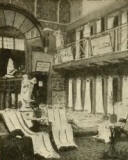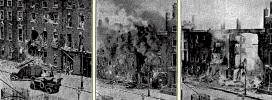3. The baths under John North, and their destruction
Ten days after the end of the court case, the baths already had a new proprietor. John North, previously manager of the County Galway Club, bought the hotel and the baths, and retained Mr Williams as his baths manager for the next eight years.19
It is not absolutely clear whether North leased the building from Barter, as Duggan had done, or whether he also bought it. This seems the most likely scenario because if Barter had merely wished to raise the rent slightly, it would have been easier and less costly to have made a new agreement with Duggan's son. But if he wanted to sell the property completely, then Duggan would not have been able to afford such a purchase. Barter's own lease on Nos. 12 and 13 had only another eleven years to run, and that on No.11 had only seventeen years, so this would have been a good opportunity for him to sell.20
 North continued the practice of regular refurbishment and renewal. In August 1890, for example, he added a fourth shampooing-room, having earlier opened a separate set of second class baths for men. These had their own entrance in Thomas's Lane at the rear of the building. They were open from six in the morning till nine at night, and cost just sixpence.21
North continued the practice of regular refurbishment and renewal. In August 1890, for example, he added a fourth shampooing-room, having earlier opened a separate set of second class baths for men. These had their own entrance in Thomas's Lane at the rear of the building. They were open from six in the morning till nine at night, and cost just sixpence.21
On 13 April 1892, North took a new 100 year lease on the hotel building.20 This gave him the confidence to extend it by the addition of public rooms which could be hired out. At the same time he installed electric lighting throughout the hotel and added a billiards room which was not only accessible from the hotel but also from the baths.22
John North, who had latterly been one of the two Vice-Presidents of the Hotel and Restaurant Proprietors Association of Ireland, died some time between 1901 and 1911, and the Hammam, together with the Donegall Street Turkish Baths in Belfast, passed to his son-in-law, Joseph Armstrong.5
If the baths continued running smoothly and uneventfully during the next few years, the Easter Rising of 1916, one of the defining moments in the struggle for Irish independence, interrupted its peaceful existence. The GPO (the General Post Office, standing on the side of O'Connell Street opposite the Hammam) became the headquarters of the Irish Volunteers. When the British woke up to what was going on, they bombarded the building. The GPO and several other buildings on that side were soon in flames, while others in the street were effectively under siege.
During this period, supplies of food for the 75 visitors and staff inside the Hammam began to run out and rations were severely reduced. There were not enough bedrooms to house everyone and the Hammam cooling-rooms 'had to be used as bedrooms for a large number of people who were unable or afraid to occupy their rooms in the hotel during the revolution.' But, continued the Irish Times, there was a lighter side.
A diversion that was much enjoyed was created by a pig hunt which took place in the lane at the rere of the hotel on Saturday evening. Two soldiers on duty failed to secure the pig and then shot the animal, which was taken into the hotel. Happy visions of rashers for supper were conjured up in the minds of the half-starved visitors. But here the difficulty was encountered of how to prepare the carcase for food. No one knew what should be done, and as a last resort the military were appealed to. Amongst the soldiers a man was found who had formerly been employed as a butcher, and he willingly consented to perform the necessary operation, 'but,' he said, 'this is our pig you have got. We have only bully beef and you have our pig.' An excited discussion followed, and at length Mr Thomas Atkins obligingly said. 'Oh, well, I'll clean him all right.' This he did in first class style, and the carcase was duly hung up in the hotel kitchen. Dismay was on every face when it was learned that the bacon would not be fit for consumption until the following Tuesday (today). There were no rashers for breakfast on Sunday.23
After the Rising was defeated, little seems to have been done to improve the baths. This is only to be expected. It would be surprising if business had been other than relatively poor, although no documentary evidence survives to confirm or refute this suggestion. Relaxation was hardly in the air. Britain was heavily involved in the 1914-18 War, and in Ireland itself there was increasing tension between the various military and political factions which was soon to culminate in the Irish Civil War (June 1922-May 1923).
If the Hammam was under siege during the Easter Rising, six years later in 1922, it was right at the centre of the fighting in O'Connell Street. On 3 July it was reported24 that during the afternoon the end of the conflict had seemed near.
…a large and expectant crowd is at this moment gathered along the quays in anticipation of seeing the white flag hoisted from the Gresham, Hammam's and other hotels in O'Connell-street amidst the bulging stout bins in which Mr de Valera [later Premier, and afterwards, President of what was to become the Republic of Ireland] and his adherents have ensconced themselves. Whether their capitulation is as imminent as seems popularly to be supposed it is quite impossible to say.
But two days later the battle for O'Connell Street was still in progress, with shots being fired from both sides of the street. The Hammam was a major target, and was spectacularly and rapidly destroyed.
There had been the usual early morning lull in hostilities, and the crowd of onlookers, which seems to beset every near approach to the actual fighting, took advantage of it to enter O'Connell-street at the lower end. They scattered on the approach of the eighteen-pounder gun, a single shot from which enlarged a breach in the ugly dull red front of the hotel. Incendiary bombs were then placed in the doorway, but these were ineffective. National soldiers entered the building, and afterwards emerged safely, having apparently encountered none of the opposing force. Immediately afterwards the flames broke out, and Hammam's was soon a roaring furnace.25

Nothing was left of Dr Barter's last public Turkish baths but a pile of bricks and masonry. Two years after the fire, Joseph Armstrong, as lessee of the Hammam, claimed £36,632 for the destruction of the hotel and Turkish baths attached, £9,982 for furniture and fittings, and £511 for his stock. The Recorder of Dublin granted the claims for the building and stock, but reduced the amount available for furniture to £7,000.26
The Recorder also attached a full reinstatement clause. This was a clause in the post-war Damage to Property (Compensation) Bill of 1923 which stated that if a building destroyed during the fighting was normally used for business or trade and contributed economically to the area, then the full cost of replacing it had to be awarded.
 But although the hotel and baths had been in the family for 35 years, Armstrong decided to call it a day. It may be that he did not have the will to start over again, or it may be that in such turbulent times he felt that his family, as protestants, would have a better life in Belfast where he already owned the
Donegall Street establishment. The site was put up for public auction.20
But although the hotel and baths had been in the family for 35 years, Armstrong decided to call it a day. It may be that he did not have the will to start over again, or it may be that in such turbulent times he felt that his family, as protestants, would have a better life in Belfast where he already owned the
Donegall Street establishment. The site was put up for public auction.20
 The Hammam was never rebuilt after it was destroyed. Offices and shops stand on the site today; their only connection with Barter's baths is the name—Hammam Buildings.
The Hammam was never rebuilt after it was destroyed. Offices and shops stand on the site today; their only connection with Barter's baths is the name—Hammam Buildings.
